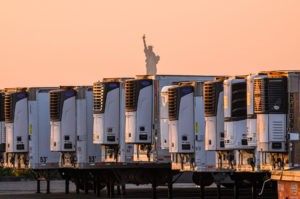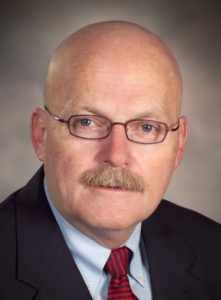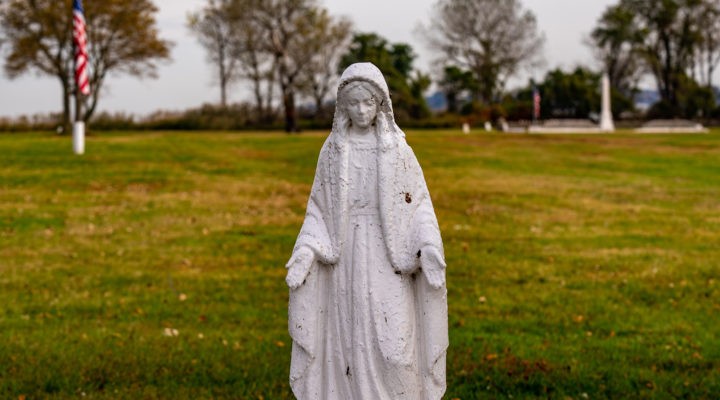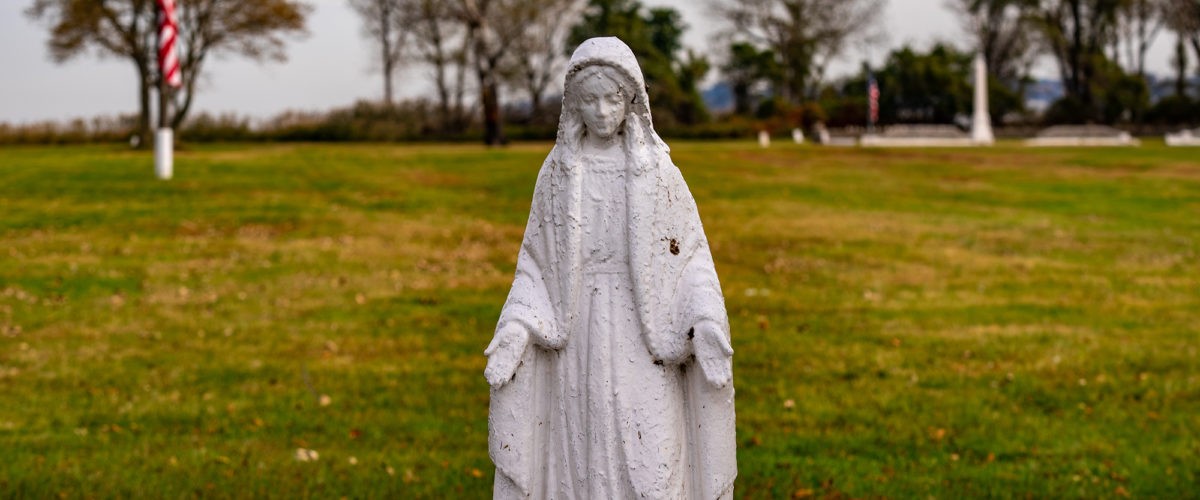“Show me the manner in which a nation cares for its dead and I will measure with mathematical exactness the tender mercies of its people, their respect for the laws of the land, and their loyalty to high ideals.” — William Gladstone, four-time prime minister of Great Britain between 1868 and 1894
Gladstone’s words were rebooted in my mind after reading a Washington Post article about the startling number of “unclaimed” corpses and cremains in the nation’s coroner/medical examiner offices and funeral homes. Mary Jordan and Kevin Sullivan, after researching the topic for six months, identified a “conservative estimate” that 1% of all deaths in the United States result in “unclaimed human remains.”

The Statue of Liberty is seen behind refrigeration trucks that function as temporary morgues at the South Brooklyn Marine Terminal during the coronavirus pandemic on May 25, 2020 in New York City. (Photo by Noam Galai/Getty Images)
Thus, in 2020, when 3.4 million Americans died, that resulted in 34,000 new remains stored in coolers, refrigerated storage units or on shelves waiting for someone to accept responsibility to bury “their” dead. Others in the field estimate 3% or 100,000 added unclaimed souls. Thus, cities — large and small — and counties — urban and rural — have become “the funeral director of last resort.”
The United States, Michael Waters wrote in The Atlantic, is “enduring a cadaver pileup.” I would add to that an urn stack up.
The Cremation Association of North America estimates that the nation’s 23,000 funeral homes may be storing more than 2 million urns or boxed bags of “cremated human remains.” Some of the remains date back decades. Increasingly, states have responded to the inventory by ordering cremations after X days or X years unclaimed.
In Los Angeles County, between 2% and 3% of the bodies of the 67,000 residents who die each year will go unclaimed.
Across the country, Maryland recorded 2,510 unclaimed bodies in 2020. In Duval County (Jacksonville) Florida, hundreds of corpses are unclaimed at any given moment. Johnnetta Moore, chief of the city’s social services, has diligently worked to locate next of kin. She explains, “To us, they are a person. They lived. They had a purpose on Earth. And they died.”
Several elements stimulate the crisis.
First, the growing number of individuals who have no family members — meaning zero — to assume the responsibility. Or no family members willing to assume the responsibility. Some individuals have outlived their families, never had a family of their own or are estranged from family. Others have lost touch with family members due to abuse, mental illness, homelessness, imprisonment, substance abuse or choice.

Maryland Cremation Services transporter Morgan Dean-McMillan gently moves the remains of a coronavirus victim onto a stretcher in the morgue at Adventist HealthCare White Oak Medical Center May 11, 2020 in Silver Spring, Maryland. (Photo by Chip Somodevilla/Getty Images)
Additionally, too many Americans do not have a will, a valid will, or a will updated to represent current relationships and priorities. Too many do not have a durable power of attorney or an executor. How many times have individuals thought, “I need to get around to making a will”?
One pastor friend buried five fathers who were will-less although having young children. He now closes every funeral with, “Do you have a will?” If only more ministers would proclaim, “Then get thee to a lawyer!” So, dear reader: Do you have a will?
Second, the number of individuals who belong to what I call “Jerry Springer families” or “families from hell.” When I do presentations on dysfunctional families for funeral director associations, invariably someone in the audience calls out, “Had one of those last week” followed by, “So did I.” Stories get exchanged during the coffee break: “You won’t believe what this family did.”
Many funeral directors or coroners have heard the callous snarl from a family member, “You can dump ’em in a ditch, for all I care.”
The legal and emotional realities of contemporary families churn up stress for funeral directors, especially when there is some money or years of unresolved familial turf battles. “Momma loved you more than me” or “Dad promised that I would get …” or “Why should we spend all this money and put it into a hole in the ground?”
As a celebrant for funerals, with difficult families I have learned to walk diplomatic tightropes to keep everyone “on good behavior,” at least until after the committal. Then they are on their own! Sometimes I look to Henry Kissinger for guidance.
Third, the opioid epidemic. The U.S. Centers for Disease Control reported that U.S. deaths from drug overdoses leapt nearly 30% to more than 93,000 in 2020 — the highest number ever recorded. Opioids were involved in 74.7% of overdose deaths; in some ZIP Codes, the increase was significantly higher.
The U.S. Centers for Disease Control reported that U.S. deaths from drug overdoses leapt nearly 30% to more than 93,000 in 2020 — the highest number ever recorded.
COVID policies prevented many individuals from seeing their therapists or participating in recovery groups. In their social isolation, mandated by COVID, addicts relapsed and died. Moreover, street drugs have become more deadly. According to Nora Volkow, director of the National Institute on Drug Abuse at the National Institutes of Health, drug suppliers frequently mix fentanyl with cocaine and methamphetamine to boost the effects. Thus, Volknow explains, “the type of drugs that are now available are much more dangerous” to users. That was confirmed by one grieving mother before I conducted the services for her 20-year-old son. She said: “He had turned his life around … .”
The bodies of too many individuals dead by overdose go unclaimed. Fourteen states budget money for burial of the unclaimed. Those allocations, however, cannot keep up with demand. For example, West Virginia, which has the highest death rate for opioid overdose, depleted their funds for providing burial the past two years.
Fourth: “How do you intend to pay for the funeral?” When I first started working in the funeral field, funeral directors were hesitant to ask for payment. Some directors said, “This is no time to talk about money. We can settle up later.” Sometimes, directors asked for a down payment for their services.
Today, a large number of funeral homes are owned by private corporations that are not reluctant to borrow words from the 1996 movie Jerry Maguire, “Show me the money.” In these mortuaries, a griever will hear, “We expect full payment before services are rendered. How would you like to pay for the services you have selected?”
“It costs money to die, to be remembered and to be buried ‘decently.’”
It costs money to die, to be remembered and to be buried “decently.” This is especially a barrier for the poor, the homeless, the mentally impaired. So, when a family does not accept the responsibility, it defaults to local municipalities, county governments, even state governments. The taxpayers foot the bill. However, government entities set limits on their compassion to specific amounts of money per funeral. Often, they must search for funeral directors who will assume responsibility for the amount of money the government provides, which is a token.
In the absence of life insurance, Social Security or military benefits, families may have to scramble to come up with the money and thus delay ritual and burial. Some families, however, are not willing to spend the life insurance — or spend all of it — to pay for a funeral and burial.
The Washington Post noted that a funeral and burial “can easily run over $7,500.” Cremation may cost between $4,000 and 5,000. There is a wide range of costs in large cities as compared to small towns. Of course, some individuals blame the funeral directors for increased costs. Frankly, everything — including your Big Mac and fries — costs more than it used to. And certainly there are discounters in the funeral field who eliminate the frills and offer “just the basics.” There are few nonprofit funeral homes in the U.S.
Some families decline to accept responsibility to bury their own dead because they cannot afford any level of services. For some, even paying for minimal services is a luxury they cannot afford, especially given the number who have lost jobs during the pandemic. Families may be embarrassed that they cannot accept the responsibility.
Fifth, the COVID pandemic. Remember, death is “no respecter of persons.”
You’ve watched news coverage of large refrigerated trailer storage units parked in hospital and funeral home parking lots to accommodate the spiraling death rate and storage demands. COVID has claimed more than 705,000 Americans. That number will continue to grow in coming months.
“Until recently, when I accepted a request to conduct a funeral or memorial service, I expected that service to be held in three or four days. Now it can be one month or more.”
COVID has had a disproportionate impact on minorities. Annie McDonough reported that COVID “upended many of the established practices” and traditions “for handling the bodies of the deceased.” Many individuals’ grief has been heightened because of mortuary restrictions on the number of individuals who may attend a visitation or funeral. The entire death care system has been severely strained. Until recently, when I accepted a request to conduct a funeral or memorial service, I expected that service to be held in three or four days. Now it can be one month or more.
Some individuals or families have made “pre-arrangements” so that X Funeral Home is notified at the time of death and removes the corpse to their facilities. If a funeral home has not been selected, the corpse is stored in the hospital morgue until a funeral director is retained by the next of kin. The funeral director then organizes a timetable for embalming, family viewing, visitation or wake, funeral or committal. However, given the numbers of COVID deaths, a funeral director may be unable to “accept” another corpse; indeed, some funeral homes have casketed corpses resting on top of pews in their chapels as well as stored in every available space in their facilities.
The director has to navigate — or negotiate — getting an internment date or a date for cremation. Some cemeteries now limit the number of committals or inurnments in a given day. Some have imposed strict COVID rules for committal services, 15 minutes or less. I conducted a graveside service with no tent and no chair for the one — one — mourner permitted to be present. I had 15 minutes, and the clock was running from the time the casket was lifted by cemetery employees out of the hearse. Oh, and it was raining. And it was Good Friday!
“I had 15 minutes, and the clock was running from the time the casket was lifted by cemetery employees out of the hearse. Oh, and it was raining.”
The delay is also reality for crematoriums. There are physical limitations on how many cremations a crematorium can handle in a 24-hour period. Given the significant number of obese corpses, new protocols have been instituted to “cool down” retorts in order to meet local air quality standards.
COVID restrictions have led some families to be in “limbo” until “all systems” are in synch. Others have chosen no services or expect to have some type of memorialization at a later date.
New York City, for example, given the incidence of COVID through its boroughs, had to establish four “mass response” disaster morgues to store corpses that hospitals cannot keep and funeral homes cannot accept.
Some funeral homes have had to transport bodies to out-of-town crematoriums, since local cremation facilities were overbooked, that increased costs and added delay in scheduling memorial services and inurnments.

Large earthmoving equipment is seen on Hart Island, in Bronx, New York on Long Island Sound, on April 16.2020. (Anthony Behar/Sipa USA)(Sipa via AP Images)
Normally, in New York City bodies only have been allowed to go “unclaimed” for 14 days; then the bodies were taken to NYC’s “potter’s field,” Hart Island, where some 1 million are buried in unmarked graves. In May 2020, the Bureau of Corrections — which, ironically, is in charge of Hart Island burials — reported burying at five times the pre-COVID rate.
Finally, New York — and other municipalities — had to acknowledge that many city residents needed longer than 14 days to claim the deceased and make arrangements. The ethnic diversity of New York City required contacting (even locating) next-of-kin in distant states and foreign countries. And individuals willing to assume the financial responsibility.
Very little attention has been given to how employees all along this death care “chain of responsibility” have dealt with stress and outrageous demands on their work schedules and their need for days off and vacations. As well as their fears of being exposed to COVID or taking it home to their families. No, they cannot “get” COVID from corpses, but they can from family members of the deceased. Many churches have prayed in worship for overworked nurses and doctors. Unfortunately, few have prayed for those who transport bodies, morticians and cemetery workers.
About ‘next of kin’
Ordinarily, at some point after death, someone who meets the legal criteria for “next of kin” steps forward, claims the corpse and makes arrangements for ritual and burial. However, as many funeral directors will tell you, determining “next of kin” is not always clear-cut.
Consider a man and woman living together, unmarried; the deceased has children by a previous marriage. The right to bury will not automatically go to the live-in de facto spouse but legally passes, in most states, to the oldest adult child. That child must be found, be capable of making decisions and be willing to accept responsibility.
Then the corpse, with accompanying paperwork to prevent mix-up, is transferred to a funeral home or, increasingly, transported to a crematorium or cemetery for what is, unfortunately, called, “direct disposal.” However, many states require that all “next of kin,” as defined by statute, sign off on the paperwork to authorize cremation. One funeral director was surprised when he asked two sisters making arrangements, “Are there any other siblings?” “Yes, we have a brother but we don’t count him as ‘family.’”
“Well,” the funeral director interrupted, “the State of New York does consider him kin.” Paperwork had to be sent to a prison for his signature before the cremation and memorial service could proceed.
Whose responsibility are the unclaimed’?
I suspect that many reading this article have no idea what happens to the unclaimed dead in their communities; some readers may not want to know. Many are unaware that historically Christians assumed responsibility for caring for the dead as an act of mercy. Or that many churches had burial grounds adjacent to the church house.
“Many are unaware that historically Christians assumed responsibility for caring for the dead as an act of mercy.”
Today, one would be hard pressed to find a megachurch that has a cemetery; admittedly, some with a more liturgical bent have mausoleum spaces.
When the Archdiocese of Los Angeles built the impressive Cathedral of Our Lady of the Angels in downtown Los Angeles, they included space to bury their bishops and archbishops and 2,000 niches for sale to the faithful. The cathedral’s website reports: “Catholic Cemeteries and Mortuaries is a ministry of the church, a beneficiary of the faithful’s daily prayers for the souls of the departed and the provider of a resting place on holy ground.”
If you have played Bible trivia, you probably have correctly answered the question, “Where was Judas buried?” Ah, that would be “Potter’s Field,” a plot of land outside Jerusalem’s city gates. Whether in a sermon, a Sunday school lesson or by reading Scripture, you learned the shameful details in Matthew’s Gospel: “After Judas betrayed Jesus for 30 pieces of silver, he threw the money back at them and went out and hung himself.”
What to do with the corpse of the betrayer who was technically “unclaimed?” Jewish leaders took the cash and arranged for Judas’ burial. How much “burial” Judas received is unknown. But it was clear that Judas’ corpse could not remain “unclaimed.” This may have been an early example of the sad decision to “just get him in the ground.”
Another question you might have been asked in Bible trivia is, “Who buried Jesus?” (Ah, “Peter, James and John” is not the correct answer. In fact, the disciples seemed to have been suddenly “unavailable.”) So, Mark’s Gospel tells us that Joseph of Arimathea “gathered up” his courage, “boldly” claimed Jesus body and arranged burial.
Joseph stepped up. Joseph acted! In writing this article, I learned about Joseph of Arimathea Societies in two Catholic high schools in Louisville, Ky. — St. Xavier and Trinity — whose students work with Catholic Charities to bury the unclaimed and indigent dead. Not only do these students “Joseph” on school days but also on holidays and during summer vacations. Indeed, by performing this care, young students learn a practical dimension of the Catholic teaching of “the seven corporal works of mercy” — the last of which is “burying the dead.”
How to make a difference
I have a hero named Peter Stefan, a Catholic mortician in Massachusetts. That state pays an $1,110 reimbursement to funeral directors who bury the indigent and unclaimed. The funeral home’s time, a casket, transportation to the funeral home, embalming, and acquiring a burial site costs at least double the stipend. Why not cremate? In some states, even the unclaimed cannot be cremated without the signatures of next of kin.
“In some states, even the unclaimed cannot be cremated without the signatures of next of kin.”
Stefan, over the years, has assumed the costs of burying many indigent persons because, as a man of faith, he believes it is his responsibility. Stefan gained notoriety when no one would claim the corpse of Tamerlan Tsarnaev, one of the brother terrorists responsible for the Boston Marathon bombing. Stefan stepped forward. Soon his funeral home had to have 24-a-day police protection; Stefan received great telephone abuse and death threats. Apparently, some in the Boston area did not want the “decent” thing to be done.
Other times, city officials step up in acts of faith.
Early in December 2020, individuals gathered in Los Angeles’ Boyle Heights Cemetery to witness clergy and county officials preside over a mass burial of the unclaimed. This service demonstrates a “single bond of recognizing the value and dignity of every single human life,” the leaders explained.
In 2020, Los Angeles County buried 1,547 individuals who had been cremated and had gone unclaimed in the Los Angeles County morgue for three years. They were buried in a large pauper’s grave. Before COVID restrictions, the event drew hundreds of people who came to publicly mourn people they did not know. Even during COVID, more than 200 attended the service digitally. Clergy from various traditions prayed in various languages that the dead “be granted the things that may have eluded them in life — deliverance from darkness, perfect rest and sheltering refuge.”
In Maricopa County, Ariz., services for the unclaimed dead take place weekly in the county-owned cemetery. A record 551 unclaimed or unknown individuals were laid to rest there last year. Maricopa County employs five individuals to attempt to identify family members of the unclaimed dead and budgets $1 million a year to care for these remains.
Who offers a witness when your county or city buries the “uncollected” dead? Who prays over those dead? Might you gather individuals from your church to attend and, perhaps, participate by offering prayers, singing or bringing flowers? Make inquiries with the coroner or medical examiner about how you might contribute to burial of the unclaimed dead.
You, too, might form a Joseph of Arimathea Society or a similar group to take a more active interest in burying the dead. Your congregation could offer to help with burial expenses for the unclaimed. Churches also might find ways to bless or show appreciation to the county coroner or medical examiner.
When Jesus taught us to care for “the least of these,” he could have meant also the unclaimed dead.

Harold Ivan Smith
Harold Ivan Smith is thanatologist and independent scholar. For 18 years he served on the teaching faculty of Saint Luke’s Hospital in Kansas City, Mo. He earned graduate degrees from Scarritt College, Vanderbilt University, and a doctor of ministry degree from Asbury Theological Seminary. His writings include A Decembered Grief, On Grieving the Death of a Father; Grieving the Death of a Mother; When You Don’t Know What to Say; When a Child You Know Is Grieving, When Your People Are Grieving: Leading in Times of Loss.
Related articles:
Ethics at the end of life: The ultimate ethical issue is whether we wait for death | Opinion by David Gushee
Tombstones or steppingstones? | Opinion by Bob Newell
It’s past time to unearth and acknowledge our role in Native American boarding schools | Analysis by Laura Ellis


